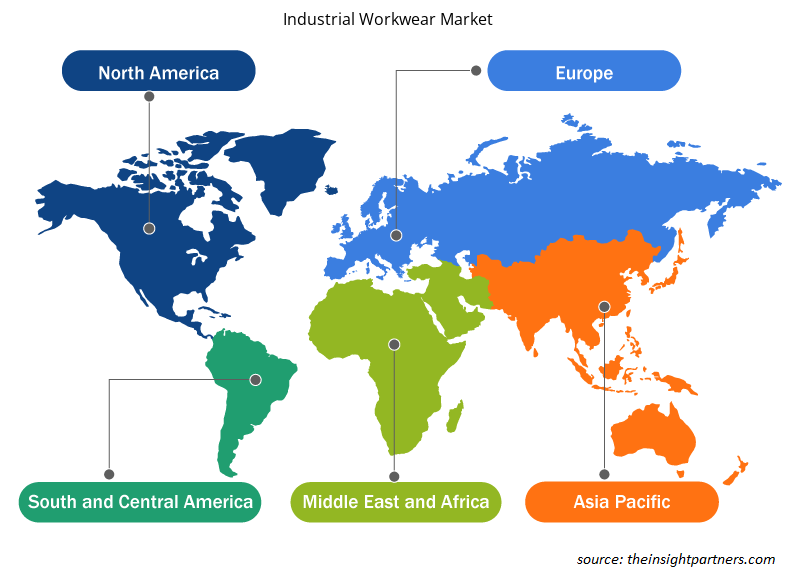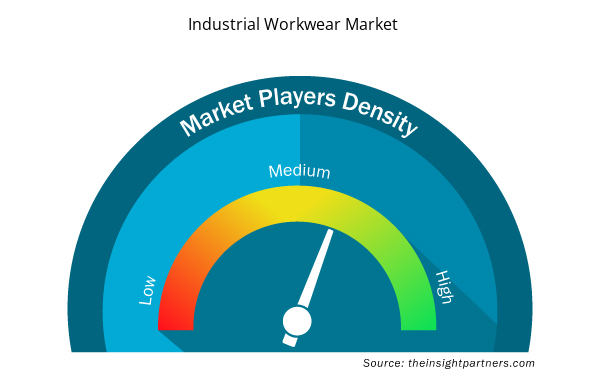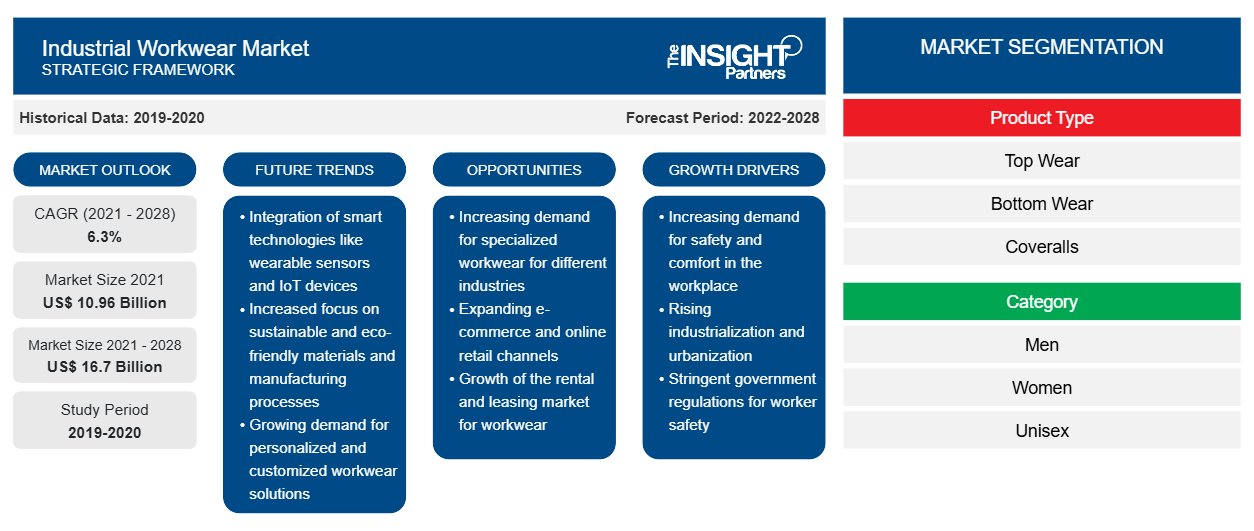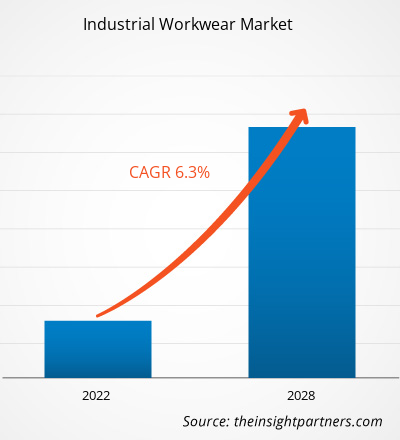産業用作業服市場は、2021年の109億5,669万米ドルから2028年には166億9,749万米ドルに達すると予測されています。2022年から2028年にかけて6.3%のCAGRで成長すると予想されています。
産業用作業服は労働者に安全を提供し、健康的な作業環境を確保します。作業服は、石油・ガス、化学、建設、製造、自動車、農業、鉱業など、さまざまな分野で広く使用されています。過去数年間、産業部門における労働者の安全に対する懸念は急速に高まっています。さまざまな政府および安全協会が労働者の安全を確保するための産業ガイドラインを課しており、作業服の需要が急増しています。
2020年には、北米が世界の産業用作業服市場で最大のシェアを占め、アジア太平洋地域は予測期間中に最高のCAGRを記録すると予測されています。中国やインドを含むアジア太平洋地域の新興国では、労働安全対策と支出が急増しており、主要な市場プレーヤーに十分な機会を提供しています。アジア太平洋地域は、労働災害の増加、インフラの貧弱さ、職場での死亡率を下げる取り組みにより、産業用作業服の重要な市場となっています。国際労働機関(ILO)が発表した2021年の報告書によると、アジア太平洋地域では、労働災害や仕事関連の病気により、毎年110万人以上の死亡が記録されています。インドなどの国では、労働力の保護、情報、訓練が最も不十分です。女性、子供、障害のある労働者、移民労働者、少数民族は、最も影響を受ける人口の一部であり、労働災害に巻き込まれることがよくあります。そのため、労働災害や怪我を減らすために、建設、製造、石油・ガス、その他多くの業界では従業員の労働安全に多大な投資が行われています。そのため、労働安全に対する意識の高まりが、アジア太平洋地域での産業用作業服の需要を促進しています。
要件に合わせてレポートをカスタマイズする
このレポートの一部、国レベルの分析、Excelデータパックなど、あらゆるレポートを無料でカスタマイズできます。また、スタートアップや大学向けのお得なオファーや割引もご利用いただけます。
- このレポートの主要な市場動向を入手してください。この無料サンプルには、市場動向から見積もりや予測に至るまでのデータ分析が含まれます。
COVID-19パンデミックが産業用作業服市場に与える影響
COVID-19パンデミックと長期にわたるロックダウンにより、石油・ガス、建設、製造、自動車、化学など、さまざまな分野で産業用作業服製品の需要が減退しました。産業用作業服は、職場での労働者の安全を確保するために、さまざまな産業分野で使用されています。しかし、2020年のCOVID-19の流行中、産業用作業服業界は前例のない課題に直面しました。産業用作業服メーカーは、全国的なロックダウン、貿易禁止、旅行制限によるサプライチェーンの制約により、大きな課題に直面しました。サプライチェーンの混乱により原材料が不足し、さまざまな産業用作業服製品の生産と流通に影響を及ぼしました。
2021年、各国政府がこれまで課していた規制の緩和を発表したことで、さまざまな経済や産業が活動を再開しました。メーカーはフル稼働を許可され、需要と供給のギャップを克服することができました。そのため、作業服メーカーは事業の再生に向けて生産の増加に注力しました。
市場分析
厳格な政府規制の導入により産業用作業服市場が活性化
職場の安全性と職場で起こりうる健康被害に関する労働者の知識不足は、世界中で大きな懸念事項となっています。これに対する意識を高めるため、多くの政府機関および非政府組織が労働者の健康と安全に関するさまざまなプログラムやキャンペーンを導入しています。米国規格協会によると、北米では米国労働省と労働安全衛生局 (OSHA) が労働安全衛生基準の分野を標準化しています。防護服の基準策定に携わる組織には、米国材料試験協会 (ASTM)、全米防火協会 (NFPA)、米国労働安全衛生研究所 (NIOSH)、米国規格協会 (ANSI)、米国繊維化学染色協会 (AATCC)、産業安全装置協会 (ISEA) などがあります。したがって、安全を確保するために産業用作業服を採用するためのこのような厳格な政府規制の導入が、市場の成長を促進すると予想されます。
製品タイプの洞察
製品タイプに基づいて、産業用作業服市場は、トップス、ボトムス、カバーオールに分類されます。トップスセグメントは、予測期間中に最大の市場シェアを占めるでしょう。ただし、カバーオールセグメントは、予測期間中に最高のCAGRを記録すると予想されます。カバーオールは、職場で全身を保護するために着用される1枚または2枚の衣服です。これらのカバーオールは、主にナイロン、綿、ポリアミド繊維で作られています。職業上の危険が高いため、一般的には塗料やコーティング、石油やガスなどの化学処理プラントや業界で使用されています。労働者を化学的、機械的、熱的、生物学的な危険から保護します。さらに、規制当局によって制定された規制に支えられた職場の安全性と意識の高まりにより、産業用作業服の需要が大幅に高まっています。
カテゴリーインサイト
カテゴリーに基づいて、産業用作業服市場は、男性、女性、ユニセックスに分類されます。予測期間中、男性セグメントが市場で最大のシェアを占める一方、ユニセックスセグメントは予測期間中に最高のCAGRを記録すると予測されています。世界銀行グループの2022年6月のレポートによると、2021年の世界の男性労働力参加率は72%でした。ほとんどの男性がさまざまな産業および企業部門で働いているため、産業用作業服の需要が高まっています。さらに、世界保健機関(WHO)の2021年9月17日のレポートによると、約200万人の男性が仕事に関連した原因で亡くなりました。したがって、労働者を職業上の怪我や死亡から守るために、メーカーは難燃性で断熱性のある産業用作業服などの新技術に注力しています。このような作業服の使用は、職業上の死亡や怪我の数を減らすのに役立ちます。
エンドユーザーインサイト
最終用途に基づいて、産業用作業服市場は、石油・ガス、建設、化学、自動車、製造、その他に分類されます。製造部門は2020年に最大の市場シェアを占めました。製造部門における産業事故の主な原因は、労働者が危険な作業環境に常にさらされていることと、労働者が保護靴を履けないことで怪我が発生することです。保護カバーオール、手袋と袖、キャップ/帽子、コート、ジャケット、シャツ、靴下、ソフトシェルジャケット、スウェットシャツ、ズボン、フェイスマスク、フェイスシールド、ウエストコート、保護ブーツと保護つま先キャップ付きの靴は、上半身と下半身を保護するために特別に設計されています。
Carhartt, Inc.、ALSICO、A.LAFONT SAS、Honeywell International Inc.、Hultafors Group、Lakeland Inc、Aramark、Ansell Ltd.、VF Corporation、Mustang Workwear は、産業用作業服市場で活動している主要企業です。これらの企業は、世界中で高まる消費者需要を満たすために、新製品の発売と地理的拡大に重点を置いています。これらの企業は、世界的に広く展開しており、世界中の多数の顧客にサービスを提供し、その結果、市場シェアを拡大しています。これらの市場企業は、専門ポートフォリオの製品範囲を拡大するために、新製品の発売と地域拡大に重点を置いています。
産業用作業服市場の地域別洞察
予測期間を通じて産業用作業服市場に影響を与える地域的な傾向と要因は、Insight Partners のアナリストによって徹底的に説明されています。このセクションでは、北米、ヨーロッパ、アジア太平洋、中東、アフリカ、南米、中米にわたる産業用作業服市場のセグメントと地理についても説明します。

- 産業用作業服市場の地域別データを入手
産業用作業服市場レポートの範囲
| レポート属性 | 詳細 |
|---|---|
| 2021年の市場規模 | 109.6億米ドル |
| 2028年までの市場規模 | 167億米ドル |
| 世界のCAGR(2021年~2028年) | 6.3% |
| 履歴データ | 2019-2020 |
| 予測期間 | 2022-2028 |
| 対象セグメント | 製品タイプ別
|
| 対象地域と国 | 北米
|
| 市場リーダーと主要企業プロフィール |
|
産業用作業服市場のプレーヤー密度:ビジネスダイナミクスへの影響を理解する
産業用作業服市場は、消費者の嗜好の変化、技術の進歩、製品の利点に対する認識の高まりなどの要因により、エンドユーザーの需要が高まり、急速に成長しています。需要が高まるにつれて、企業は提供品を拡大し、消費者のニーズを満たすために革新し、新たなトレンドを活用し、市場の成長をさらに促進しています。
市場プレーヤー密度とは、特定の市場または業界内で活動している企業または会社の分布を指します。これは、特定の市場スペースに、その規模または総市場価値と比較して、どれだけの競合相手 (市場プレーヤー) が存在するかを示します。
産業用作業服市場で事業を展開している主要企業は次のとおりです。
- カーハート株式会社
- アラマーク
- アルシコグループ
- A.ラフォンSAS
- ハネウェルインターナショナル株式会社
免責事項:上記の企業は、特定の順序でランク付けされていません。

- 産業用作業服市場のトップキープレーヤーの概要を入手
レポートの注目点
- 産業用作業服市場における進歩的な業界動向は、企業が効果的な長期戦略を策定するのに役立ちます。
- 先進国と発展途上国の産業用作業服市場のプレーヤーが採用しているビジネス成長戦略
- 2020年から2028年までの市場の定量分析
- 作業服の世界需要の推定
- 産業用作業服市場におけるバイヤーとサプライヤーの有効性を示すポーターのファイブフォース分析
- 競争市場の状況を理解するための最近の動向
- 産業用作業服市場の成長を牽引・抑制する要因と市場動向および展望
- 商業的利益を支える市場戦略を強調することで意思決定プロセスを支援する
- さまざまなノードにおける産業用作業服市場の規模
- 詳細な概要と産業用作業服業界の動向
- 有望な成長機会のあるさまざまな地域の産業用作業服市場の規模
- 過去2年間の分析、基準年、CAGRによる予測(7年間)
- PEST分析とSWOT分析
- 市場規模価値/数量 - 世界、地域、国
- 業界と競争環境
- Excel データセット


- Medical Second Opinion Market
- Pharmacovigilance and Drug Safety Software Market
- Queue Management System Market
- Industrial Inkjet Printers Market
- Space Situational Awareness (SSA) Market
- Energy Recovery Ventilator Market
- Oxy-fuel Combustion Technology Market
- Webbing Market
- Identity Verification Market
- USB Device Market

Report Coverage
Revenue forecast, Company Analysis, Industry landscape, Growth factors, and Trends

Segment Covered
This text is related
to segments covered.

Regional Scope
North America, Europe, Asia Pacific, Middle East & Africa, South & Central America

Country Scope
This text is related
to country scope.
よくある質問
The major players operating in the global industrial workwear market are Carhartt, Inc.; Aramark; Alsico group; A. LAFONT SAS; Honeywell International, Inc.; Hultafors Group AB; Lakeland Industries, Inc.; VF Corporation; Ansell Ltd.; and Mustang Workwear.
Rising demand for emerging economies is anticipated lucrative opportunities for the growth of the industrial workwear market. Emerging economies are experiencing development in various sectors, including automotive, manufacturing, and chemicals. The automotive industry is one of the largest industries in the world, and it is growing in emerging economies, such as China, India, and Brazil. The growth in the region is attributed to the rising foreign direct investments, growing passenger car demand, and increasing preference for electric vehicles to reduce emissions. The increasing development in various industrial sectors of emerging economies has propelled the need to maintain the safety of workers while working. Thus, rapid development in industrial sectors of emerging economies is anticipated to create lucrative opportunities for the industrial workwear market during the forecast period.
Based on the application, the oil and gas segment is projected to grow at a significant CAGR over the forecast period. The oil & gas industry workers often face the risk of fire and explosion due to the ignition of flammable vapors or gases. Hence, companies demand flame-resistant and insulated industrial workwear to protect workers from fire and explosion-related injuries. Moreover, industrial workwear manufacturers are continuously adopting new business expansion strategies such as mergers, acquisitions, and collaboration to meet the workers’ demand globally. On February 8, 2022, Tyndale USA expanded its services in Canada to cater to the demand for fire-resistance top wear and bottom wear from Canada-based oil & gas companies. Such strategic adoption by players is driving the demand for industrial workwear in the oil & gas industry.
Based on type, the topwear segment has the largest revenue. Top wear products mainly include shirts, t-shirts, jackets, and vests. They are often made of cotton, silk, wool, polyester, polyamide, nylon, and acrylic fibres. The growth of the corporate sector propels the demand for top wear as internal policies allow an employer to set dress codes that the employees are required to follow. Growing industrial sectors, such as construction, oil & gas, chemicals, automotive, mining, and manufacturing, and rising awareness regarding workers’ safety in these sectors bolster the growth of the industrial workwear market for the top wear segment.
North America accounted for the largest share of the global industrial workwear market. An increase in cases of occupational injuries and a rise in the number of surgeries and occupational deaths have led to high demand for safety apparel and an increase in expenditure on work safety by end-use industries such as oil & gas, food processors, manufacturing, automotive, mining, and agriculture. In addition, stringent government regulations in the region regarding the safety of working professionals in factories and on-site workers, coupled with penalties for non-compliance with the standards, augmented the adoption of industrial workwear. The rise in demand for industrial workwear, mainly from oil & gas, chemical, construction, mining, and other industries, is fueling the market growth in the region. Workers across these industries are exposed to various risks owing to the nature of the job or task. Therefore, these industries require functional and high-performance protective workwear which can endure extremities at the workplace.
An increase in the number of industrial accidents driving the global industrial workwear market. Owing to the increasing number of industrial accidents, employers are adopting several standards defined by national and international organizations to ensure the well-being and safety of their employees at the workplace. Industrial workwear is designed to provide protection, durability, and comfort to employees while working across diversified industrial bases and helps them avoid severe casualties at the workplace, thereby improving the working efficiency of the workers. Thus, an increase in industrial accidents and work-related mortality propel the demand for industrial workwear to ensure the workers’ safety, which, in turn, drives the market growth. Over the past, successive major accidents in the chemical industry have caused deaths, numerous injuries, significant environmental pollution, and massive economic loss. According to the Environmental Ministry, the number of deaths in the chemical industry has reduced by nearly 41% from 2015 to 2018, while the number of injured has significantly gone up. The increased number of accidents in the industry has raised concerns regarding workers’ safety and resulted in the implementation of stringent regulations for their safety.
Trends and growth analysis reports related to Consumer Goods : READ MORE..
The List of Companies - Industrial Workwear Market
- Carhartt, Inc.
- Aramark
- Alsico group
- A. LAFONT SAS
- Honeywell International, Inc.
- Hultafors Group AB
- Lakeland Industries, Inc.
- VF Corporation
- Ansell Ltd.
- Mustang Workwear
The Insight Partners performs research in 4 major stages: Data Collection & Secondary Research, Primary Research, Data Analysis and Data Triangulation & Final Review.
- Data Collection and Secondary Research:
As a market research and consulting firm operating from a decade, we have published and advised several client across the globe. First step for any study will start with an assessment of currently available data and insights from existing reports. Further, historical and current market information is collected from Investor Presentations, Annual Reports, SEC Filings, etc., and other information related to company’s performance and market positioning are gathered from Paid Databases (Factiva, Hoovers, and Reuters) and various other publications available in public domain.
Several associations trade associates, technical forums, institutes, societies and organization are accessed to gain technical as well as market related insights through their publications such as research papers, blogs and press releases related to the studies are referred to get cues about the market. Further, white papers, journals, magazines, and other news articles published in last 3 years are scrutinized and analyzed to understand the current market trends.
- Primary Research:
The primarily interview analysis comprise of data obtained from industry participants interview and answers to survey questions gathered by in-house primary team.
For primary research, interviews are conducted with industry experts/CEOs/Marketing Managers/VPs/Subject Matter Experts from both demand and supply side to get a 360-degree view of the market. The primary team conducts several interviews based on the complexity of the markets to understand the various market trends and dynamics which makes research more credible and precise.
A typical research interview fulfils the following functions:
- Provides first-hand information on the market size, market trends, growth trends, competitive landscape, and outlook
- Validates and strengthens in-house secondary research findings
- Develops the analysis team’s expertise and market understanding
Primary research involves email interactions and telephone interviews for each market, category, segment, and sub-segment across geographies. The participants who typically take part in such a process include, but are not limited to:
- Industry participants: VPs, business development managers, market intelligence managers and national sales managers
- Outside experts: Valuation experts, research analysts and key opinion leaders specializing in the electronics and semiconductor industry.
Below is the breakup of our primary respondents by company, designation, and region:

Once we receive the confirmation from primary research sources or primary respondents, we finalize the base year market estimation and forecast the data as per the macroeconomic and microeconomic factors assessed during data collection.
- Data Analysis:
Once data is validated through both secondary as well as primary respondents, we finalize the market estimations by hypothesis formulation and factor analysis at regional and country level.
- Macro-Economic Factor Analysis:
We analyse macroeconomic indicators such the gross domestic product (GDP), increase in the demand for goods and services across industries, technological advancement, regional economic growth, governmental policies, the influence of COVID-19, PEST analysis, and other aspects. This analysis aids in setting benchmarks for various nations/regions and approximating market splits. Additionally, the general trend of the aforementioned components aid in determining the market's development possibilities.
- Country Level Data:
Various factors that are especially aligned to the country are taken into account to determine the market size for a certain area and country, including the presence of vendors, such as headquarters and offices, the country's GDP, demand patterns, and industry growth. To comprehend the market dynamics for the nation, a number of growth variables, inhibitors, application areas, and current market trends are researched. The aforementioned elements aid in determining the country's overall market's growth potential.
- Company Profile:
The “Table of Contents” is formulated by listing and analyzing more than 25 - 30 companies operating in the market ecosystem across geographies. However, we profile only 10 companies as a standard practice in our syndicate reports. These 10 companies comprise leading, emerging, and regional players. Nonetheless, our analysis is not restricted to the 10 listed companies, we also analyze other companies present in the market to develop a holistic view and understand the prevailing trends. The “Company Profiles” section in the report covers key facts, business description, products & services, financial information, SWOT analysis, and key developments. The financial information presented is extracted from the annual reports and official documents of the publicly listed companies. Upon collecting the information for the sections of respective companies, we verify them via various primary sources and then compile the data in respective company profiles. The company level information helps us in deriving the base number as well as in forecasting the market size.
- Developing Base Number:
Aggregation of sales statistics (2020-2022) and macro-economic factor, and other secondary and primary research insights are utilized to arrive at base number and related market shares for 2022. The data gaps are identified in this step and relevant market data is analyzed, collected from paid primary interviews or databases. On finalizing the base year market size, forecasts are developed on the basis of macro-economic, industry and market growth factors and company level analysis.
- Data Triangulation and Final Review:
The market findings and base year market size calculations are validated from supply as well as demand side. Demand side validations are based on macro-economic factor analysis and benchmarks for respective regions and countries. In case of supply side validations, revenues of major companies are estimated (in case not available) based on industry benchmark, approximate number of employees, product portfolio, and primary interviews revenues are gathered. Further revenue from target product/service segment is assessed to avoid overshooting of market statistics. In case of heavy deviations between supply and demand side values, all thes steps are repeated to achieve synchronization.
We follow an iterative model, wherein we share our research findings with Subject Matter Experts (SME’s) and Key Opinion Leaders (KOLs) until consensus view of the market is not formulated – this model negates any drastic deviation in the opinions of experts. Only validated and universally acceptable research findings are quoted in our reports.
We have important check points that we use to validate our research findings – which we call – data triangulation, where we validate the information, we generate from secondary sources with primary interviews and then we re-validate with our internal data bases and Subject matter experts. This comprehensive model enables us to deliver high quality, reliable data in shortest possible time.


 このレポートの無料サンプルを入手する
このレポートの無料サンプルを入手する